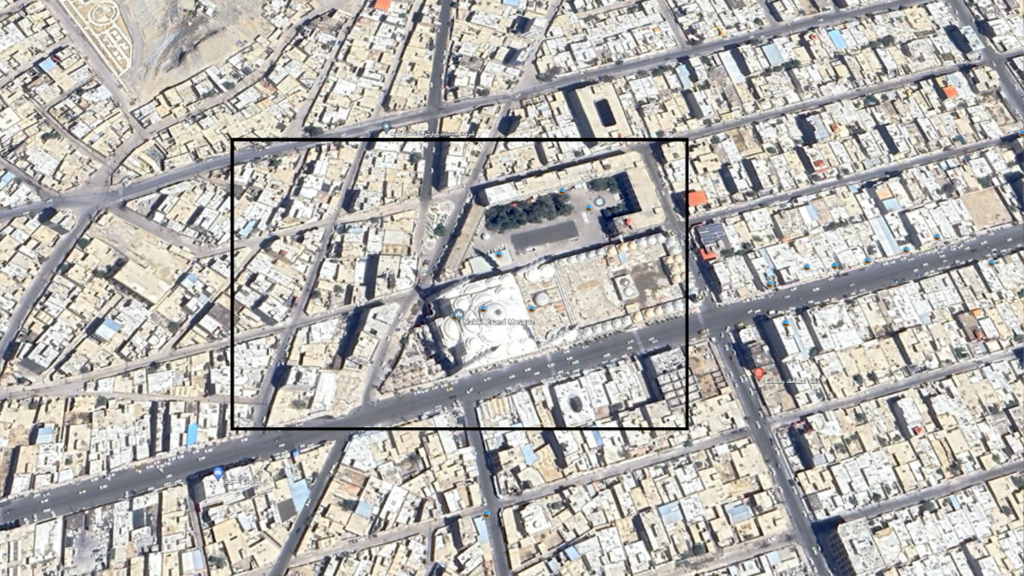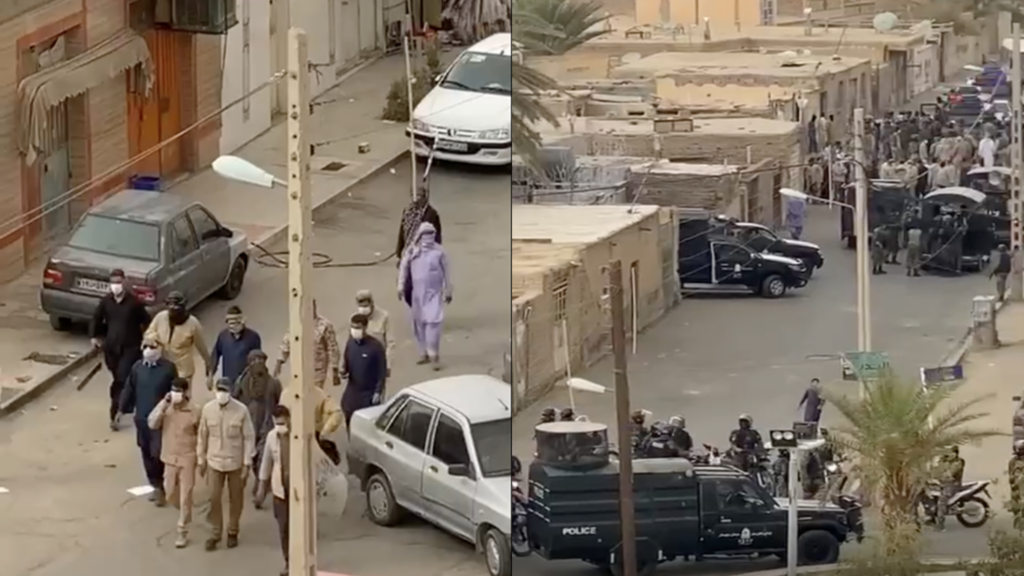Amnesty International has documented how the Iranian authorities’ relentless onslaught against weekly protests by thousands of protesters and worshippers from Iran’s Zahedan, Sistan and Baluchistan province, escalated on Friday 20 October 2023, as security forces resorted to severe beatings and unnecessary use of tear gas and water cannons, and carried out mass arbitrary arrests, enforced disappearance, and torture and other ill-treatment.
Amnesty International’s Crisis Evidence Lab reviewed 32 images and videos posted online on 20 October 2023, corroborating eyewitness accounts obtained by the organization about a brutal attack against thousands of worshippers and peaceful protesters, including children as young as 10.
The attack involved the arbitrary arrest of hundreds of people, including scores of children, in a violent manner. Many of those who were arbitrarily arrested remain forcibly disappeared. Amnesty International’s research has revealed widespread torture and other ill-treatment against both child and adult detainees, including severe beatings and injuries from paintball launchers fired at close range.
A torrent of gunfire and brutal beatings
As Friday prayers concluded at 1pm on 20 October, security forces began hurling stones at thousands of worshippers peacefully leaving the Great Mosallah, the city’s large prayer site. More than a thousand worshippers, who were among the first to leave the prayer site, began chanting while peacefully marching down Razi Street.
Amnesty International verified three videos showing peaceful protesters walking in the direction of the Grand Makki Mosque.
According to eyewitnesses, security forces encircled thousands of remaining worshippers exiting the Great Mosallah prayer site and ordered them to wait until “the situation calmed”.
Minutes later, security forces unlawfully fired tear gas and, on occasion, shotguns towards the peaceful protesters. An eyewitness reported seeing several teenagers with birdshot pellets lodged in their heads and chests.
Amnesty International considers that the security forces’ use of birdshot violates the absolute prohibition on torture and other ill-treatment given the serious harm to physical integrity and the mental trauma that this conduct causes to protesters and the fact that it is deployed for the purpose of inflicting severe harm and suffering on protesters to intimidate and punish them and to crush protests.
Protesters dispersed after security forces used gunfire and water cannon spraying a yellow-coloured liquid. The use of dye means large numbers of people, including peaceful protesters, can be indiscriminately marked, which can lead to unwarranted harassment or arbitrary detention after the event.
Amnesty International reviewed three videos that capture security forces using water cannon. Protesters, including children, are seen chanting in outrage and filming the crackdown or fleeing in distress. A small minority of protesters responded by throwing stones.
Under international law and standards, tear gas and water cannon may only be used as a last resort for dispersal if violence has become widespread and so reached such a scale that security forces cannot contain the threat by targeted means affecting only those individuals who are using violence. Even if some protesters engage in stone throwing or other violent actions, this does not turn an otherwise peaceful protest into a non-peaceful assembly. Security forces should ensure that those who remain peaceful can continue protesting. Law enforcement officers must also issue an appropriate warning in advance and ensure that people have both time to obey the warning and a safe space to move to.
Another video reviewed by Amnesty International and reproduced below depicts the heavy presence of the Special Forces of Iran’s police (yegan-e vijeh) at the protest site, with two sounds of gunfire audible in the background.
Eyewitnesses told Amnesty International that security forces chased fleeing protesters, beating and violently arresting anyone within their reach, including children. An eyewitness recalled, “Security forces pursued people with batons. They struck them hard on the heads and bodies. I saw them kicking children as young as 10 as well as youth and older people. Their treatment of the people was insulting and degrading. They fired tear gas and then charged in to apprehend people. They dragged protesters across the ground while punching and kicking them.”
Two videos verified by Amnesty International capture these acts of brutality against the protesters. Security forces are seen chasing protesters after they disperse, subjecting them to kicking, punching, and beatings with batons, and carrying out violent arrests. The security forces involved include the Special Forces of Iran’s police (yegan-e vijeh) in uniforms as well as plainclothes agents.
These videos show security forces striking protesters even when they are not resisting. This suggests the strikes were administered as a means of repression and punishment to crush peaceful protests, to inflict pain and fear on protesters and to deter them and others from further protests. This violates the absolute prohibition of torture and cruel, inhuman or degrading treatment or punishment.
Under international law and standards, batons must never be used as a means of punishment, to disperse peaceful protests, or against people who are already restrained. As a rule, batons should only be used to defend against violent attacks, and only if no less harmful alternative is available. Police must attempt to deescalate the situation by issuing clear verbal warnings before using batons, and should use them in a way that minimizes physical harm. Striking people on the head, face or neck, or striking people repeatedly, is almost never justified.
Eyewitnesses also recounted that security forces fired tear gas inside the courtyard of the Grand Makki Mosque after hundreds of protesters took refuge there, and violently arrested the staff guarding its entrance. This again is in contravention of international human rights law and standards which specify that tear gas should not be used in confined spaces (where escape may be difficult).
According to eyewitnesses, while the protesters dispersed by around 2:30pm, security forces continued to carry out arbitrary arrests, targeting those who left the mosque and others suspected of participating in protests.
Eyewitnesses told Amnesty International that after Haalvsh, a Baluchi human rights group outside Iran, published several videos on 20 October 2023, capturing the crackdown from a higher vantage point, security forces raided a residential building overlooking Grand Makki Mosque to arrest individuals they suspected of filming the videos.
Gearing up for more violence
Eyewitnesses said there was a noticeable increase in the deployment of security forces throughout Zahedan on the morning of the attack, suggesting a calculated crackdown. One human rights defender described how the city resembled an “army barracks”. Security forces erected new checkpoints on the streets leading to the Great Mosallah, conducting body searches and preventing people without identification documents from proceeding to the prayer site.

Amnesty International reviewed 13 photos and videos showing the arrival and presence of the large group of security forces blocking the roads around the Grand Makki Mosque. The largest deployment of security forces’ vehicles and personnel was centred near the mosque library and surrounding streets.
According to evidence gathered by Amnesty International, the security forces involved in the crackdown include the Special Forces of Iran’s police (yegan-vijeh), Revolutionary Guards agents in uniforms, and plainclothes agents, with some wearing traditional Baluchi clothes and concealing their faces with masks.

Amnesty International believes that the latest escalation is linked to heightened efforts to quell weekly protests in Zahedan, including during high-level visits to the province by Revolutionary Guards commander Mohammad Pakpour. Haalvsh has reported that in September 2023, the chief of Iran’s police, Ahmadreza Radan, threatened local tribal and religious leaders over the weekly protests, which have been taking place since the “Woman Life Freedom” uprising erupted more than a year ago, and insisted that families of those killed during the bloody Friday on 30 September 2022 in Zahedan must accept state-funded financial compensation and cease demands for criminal accountability.
This is consistent with warnings to protesters and worshippers on 20 October 2023 to refrain from attending future prayers at Mosalla or else “face the consequences”.
Local residents fear that authorities are gearing up for more bloodshed. One woman urged Amnesty International to “ensure the voices of Baluchi protesters are heard” saying, “We have faced violent repression for an entire year. Our situation is dire, and further grim incidents might happen on any given Friday.”
Global action needed
Amnesty International calls on all states to urgently call on the Iranian authorities to:
- Refrain from the unlawful use of force and firearms against
- Release children and all others detained solely for peacefully exercising their rights;
: - Stop subjecting detainees to enforced disappearance
s, torture and other ill-treatment, and ensure that persons have access to independent lawyers of their own choosing from the moment of arrest;
- Allow unimpeded access to the UN Fact Finding Mission to investigate human rights violations related to the uprising.
The crisis of systemic impunity in Iran enabled this new wave of mass arbitrary arrests, torture and other abuses against protesters including children. This underscores the need for states worldwide to pursue pathways for justice at the international level.
Amnesty International, therefore, reiterates its call on states to:
- Consider exercising universal and other extraterritorial jurisdiction in relation to crimes under international law committed by Iranian authorities, irrespective of the absence or presence of the accused in their territory. This includes initiating adequately resourced criminal investigations aimed at disclosing the truth about the crimes, identifying those suspected of responsibility, including commanders and other superiors, and issuing, when there is sufficient admissible evidence, international arrest warrants.


